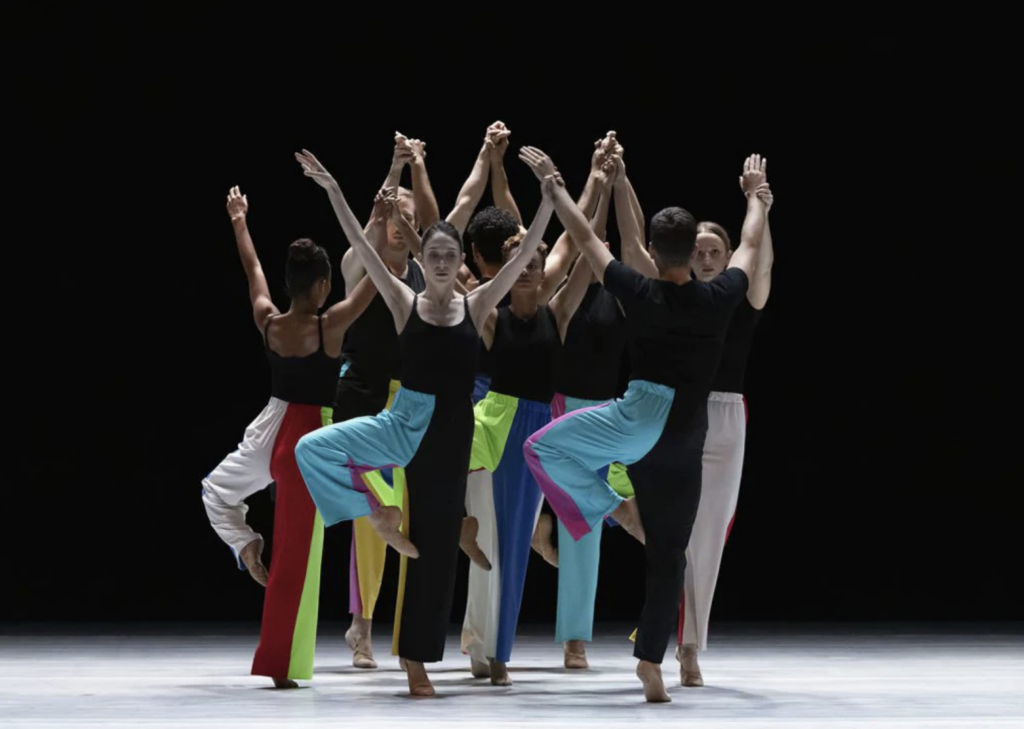Opening Night
Gerald R. Ford Amphitheater
L.A. Dance Project returns to Vail this summer to present a program of three works that have several unique traits in common. All were created relatively recently—in the last 5 years—and all by female choreographers. Bobbi Jene Smith’s Quartet for Five was created in collaboration with Or Schraiber in 2022 and Madeline Hollander’s 5 Live Calibrations premiered in 2019, both choreographed for LADP. Pam Tanowitz’s Everyone Keeps Me was commissioned by The Royal Ballet in 2019.
In listening to these women talk about their choreographic processes, I noticed a pattern. All of them were interested primarily in the presence and relationships between the dancers in the studio, creating movement not just on the dancers, but for them, or even out of them. Rather than entering the studio with pre-conceived choreographic notions prepared to be demonstrated and then repeated back, these women entered the studio ready for anything to happen. What follows is a peek into each of the 3 works on the LADP program and some insight from each of the choreographers on their processes.
Quartet for Five
“The humanity and the people in the work is the driving force in what I’m trying to do,”(1) says Bobbi Jene Smith. Her piece Quartet for Five explores the various relationships that exist between the five dancers moving to Philip Glass’ String Quartet No. 5. In a recent interview with Juilliard’s Dean and Director of Dance Alicia Graf Mack, Smith said she is learning to “trust the people in the room, always meet them with open hands” and “that we make this piece together.” (2)
Everyone Keeps Me
Pam Tanowitz’ process can be summarized by the question, “What happens if…?” In an hour-long Royal Ballet rehearsal that was streamed on YouTube, Tanowitz rehearses 2 solos from Everyone Keeps Me in front of an audience. While talking with Hannah Grennell, First Artist of The Royal Ballet, Tanowitz starts a sentence with, “What happens if…” after which, she proposed a variation of the move for Hannah—a possibility, an option—which Hannah could try on her body and either accept, reject, or alter. The phrase “What happens if…” reveals that her process is grounded in curiosity. As the choreographer, Tanowitz could ask an identical “what happens if…” question to two different dancers and get two different choreographic results. How interesting to realize the outcome of a work is as dependent on the dancers as it is on the choreographer.
After explaining the humorous and personal source of one step in the ballet, which Grennell affectionately referred to as “holding a hamster,” Tanowitz quickly re-grounded the conversation by saying,
“What’s serious and interesting to me about it is, when I work with dancers, the history that they carry in their bodies—I mean that’s the collaboration. A lot of times we talk about ‘we collaborate with composers’ or ‘we collaborate with lighting design,’ but the real collaboration for me is in the room with the dancers. Because I didn’t teach Hannah how to dance, I had nothing to do with her technique. She’s coming to me with all this history in her body: of ballet, of the Royal Ballet, of all of her experiences. So that’s what I’m working with; it’s really exciting.”(3)

5 Live Calibrations
Before choreographing 5 Live Calibrations, Madeline Hollander had not yet created a work for the stage. In a phone interview she explained, “I typically make work for art institutions such as museums, galleries, or public spaces. So I’m not used to having a beginning and an end.” To bring her experience with live and looping performances to the stage, she landed on a concept that created the illusion of the dancers moving indefinitely. She described the open curtain as a frame through which the audience peeks in on the dancers at a moment in time, but that we should assume when the curtain is down, the dancing continues without our presence.
“It’s kind of like if you put a curtain over a fish tank and then you reveal the tank and they are all doing their thing, and then you cover it back up, and the fish are continuously living their lives. When you pull the curtain back again, you see them still there but in totally different positions” (4)
Hollander explained how each of the five movements was inspired and driven by different calibration techniques. “Whether it’s calibrating color on a projector, or calibrating balance when you’re dizzy; from planetary to molecular calibration exercises, we started piecing together movements and mapping them onto the human body.” From these exercises, Hollander and the dancers developed contests and games that take place within the work. The outcome of each game determines how the dancers proceed in the next section. For example, the curtain rises on the first of five movements to reveal a balancing competition. As each dancer loses their balance—and that happens in a different order every time—they move on to their next physical task while adjusting to the unique pattern of movement created around them as their peers fight for and inevitably fall out of their balances.
Says Hollander, “I think it’s more fun for the audience to kind of view it like watching a sports game unfold. They know the rules of the soccer game, but you don’t know who’s going to make the goal.” And that goes for the dancers, too! As the winner of the game is different in every performance, the work is as new to the dancers as it is to the audience each time. And as Gia Kourlas said in her New York Times review, “You don’t have to understand the game to appreciate the arresting results.” (6)
Notes:
Image:
Baiano, Erin. LADP in Madeline Hollander’s 5 Live Calibrations. 2022. Photograph. May 14, 2022. https://www.erinbaiano.com